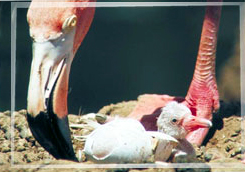SIZE
1. The greater flamingo is the tallest flamingo, standing 120 to 150 cm (47-59 in.) and weighing up to 3.5 kg (7.7 lb.).
2. The lesser flamingo is the smallest flamingo, standing 80 cm (31.5 in.) and weighing only 2.5 kg (5.5 lb.).
3. Males reach full size between one-and-a-half and two years.
4. Male flamingos are slightly larger than females, weighing more and having longer wingspans; however, visual sex determination of flamingos is unreliable.
5. The wingspan of flamingos ranges from 95 to 100 cm (37-39 in.) for the lesser flamingo to 140 to 165 cm (55-65 in.) for the greater flamingo. The Caribbean flamingo has a wingspan of 150 cm (59 in.).
COLORATION
1. Feather color varies with species, ranging from pale pink to crimson or vermilion.
- Caribbean flamingos have the brightest coloration: crimson or vermilion.
- The Chilean flamingo is pale pink.
2. Feather coloration is derived from carotenoid pigments found in a flamingo’s food.
3. Male and female flamingo coloration is the same.
4. Newly-hatched chicks are gray or white.

6. Parents may lose some of their pink coloration while raising young.
7. Coloration of a flamingo’s legs and feet varies according to species – from yellow to orange or pink-red. The Andean flamingo is the only species that has yellow legs and feet.


